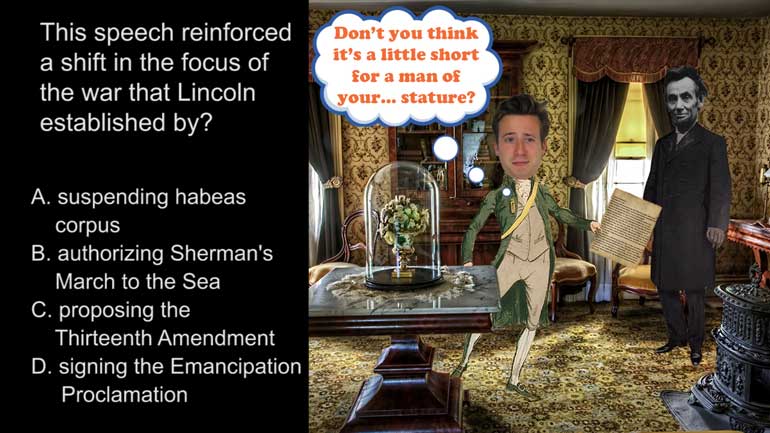ShmoopTube
Where Monty Python meets your 10th grade teacher.
Search Thousands of Shmoop Videos
AP U.S. History 2.4 Period 4: 1800-1848 255 Views
Share It!
Description:
The painting in this video reflects what growing aesthetic trend among Americans in the early 19th century? We really hope it's that painting of the dogs playing poker. That's a masterpiece.
Transcript
- 00:00
[ musical flourish ]
- 00:03
And here's your Shmoop du jour, brought to you by the Hudson River School,
- 00:07
voted the number one party school by Trout Monthly.
- 00:13
All right, the painting pictured above reflects what growing
- 00:16
aesthetic trend among Americans in the early 19th century?
Full Transcript
- 00:19
And here are your potential answers.
- 00:21
[ buzz ]
- 00:23
[ mumbles ]
- 00:26
[ mumbling continues ]
- 00:28
All right. Well, how can we describe the aesthetic of this painting?
- 00:32
Well, it's a very detailed landscape, that's for sure.
- 00:34
And we see a man in the bottom left corner taking in the beauty of the outdoors.
- 00:39
Is that Al Gore? All right.
- 00:41
If you look in the middle there, we see that there are some buildings,
- 00:44
which could represent man starting to make his
- 00:47
mark on the world around him.
- 00:49
All right, let's keep all those in the back of our heads as we look at the answers.
- 00:53
So does the painting reflect the trend of
- 00:56
B - a shifting focus toward pessimism and disillusionment?
- 01:02
Well, all those gentle colors make the painting feel
- 01:05
pretty rosy and idyllic.
- 01:06
In fact, these painters were often referred to as "Romantics."
- 01:10
No, not Romeo and Juliet romantics, but Romantics
- 01:13
with the idealized belief that humans and nature could
- 01:17
peacefully coexist.
- 01:19
So that knocks out B and D.
- 01:21
Could this aesthetic trend have reflected
- 01:23
C - a refutation of religious subjects and piety?
- 01:27
Well, take a look at the painting again.
- 01:29
That man in the corner? The painters usually put
- 01:31
a white settler in their landscapes to signify that
- 01:34
God had created the land specifically for them.
- 01:38
Which is also why you see those buildings in the distance.
- 01:40
Obviously, much of this land already had inhabitants.
- 01:43
But that wasn't really a concern for the artists.
- 01:46
So it's not C, either.
- 01:47
That means that these landscape paintings emphasized
- 01:50
A - a combination of European forms and American ideas.
- 01:55
This epic, sweeping form of landscape painting was originally developed in Europe,
- 01:59
where every artist meticulously captured every detail.
- 02:02
But the overwhelming grandeur of the landscape
- 02:04
and that explorer in the foreground?
- 02:06
Well, ready to take it on?
- 02:08
Those were American ideas implanted on top of
- 02:11
a traditionally European form. So the answer is A.
- 02:14
Eventually, critics referred to American landscapes as
- 02:17
relatively paint-by-numbers.
- 02:19
Uh, but at least they were very patriotic numbers.
- 02:22
[ roaring ]
Up Next
AP U.S. History Exam 2.45. The journey shown on the map was an example of...what?
Related Videos
AP U.S. History Exam 2.26. This speech reinforced a shift in the focus of the war that Lincoln established by...what?
What did the Spanish messengers bring with them to North America? Hint: you probably wouldn't be thrilled to get this for your next birthday.
AP U.S. History Diagnostic 24. How did the United States choose containment over the National Security Council Report in Latin America?
AP U.S. History Exam 2.25. In writing the Gettysburg Address, Lincoln was still working to win over Northern voters who believed that...what?




